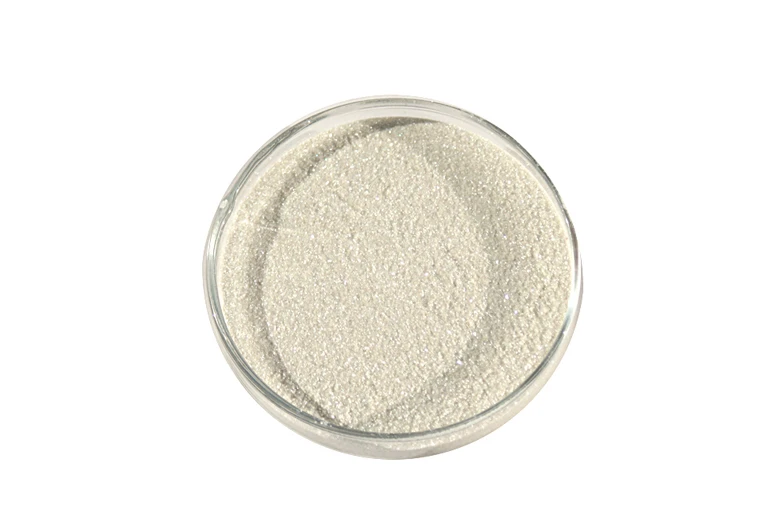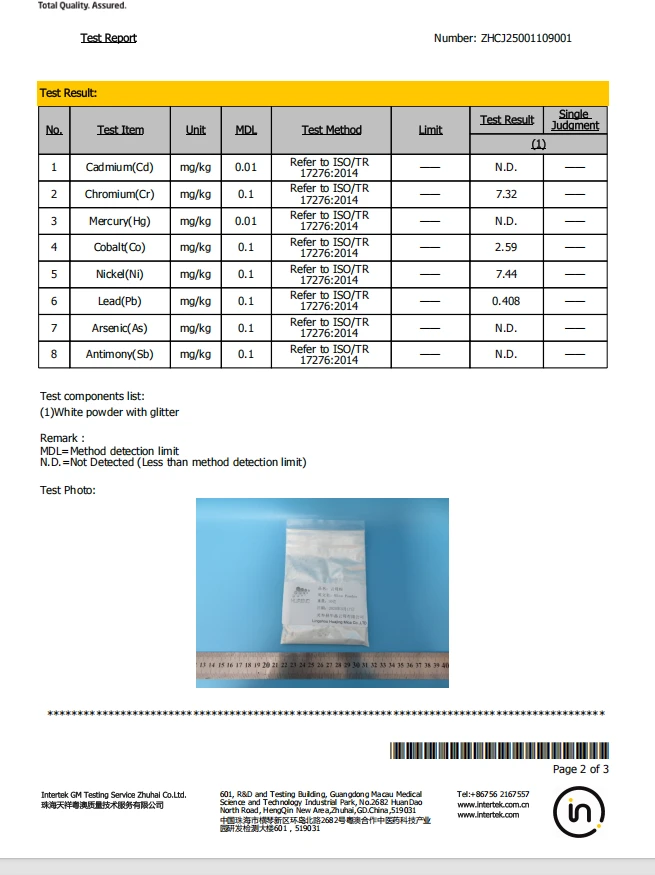Synthetic Fluorphlogopite Safe & Versatile Cosmetic Shimmer
- Composition and technical specifications of synthetic fluorphlogopite
- Performance comparison: Synthetic vs natural alternatives
- Leading global manufacturers and distribution channels
- Custom formulation protocols and surface modification options
- Cosmetic application case studies with visual evidence
- Toxicological safety profile and dermatological testing data
- Procurement considerations and industry adaptation roadmap

(synthetic fluorphlogopite)
Composition and Technical Specifications of Synthetic Fluorphlogopite
Synthetic fluorphlogopite represents a laboratory-engineered mica derivative composed primarily of potassium, magnesium, aluminum silicate fluoride. Created through high-temperature fusion processes exceeding 1500°C, this material achieves 99.6% optical purity with controlled particle dimensions ranging from 5-250 microns. The synthesis eliminates natural mineral impurities, yielding batch-to-batch consistency with refractive indices between 1.58–1.62, closely matching human skin's light diffusion properties.
Crystalline structure analysis reveals perfect basal cleavage planes that scatter light uniformly. Unlike natural mica, synthetic versions contain zero detectable heavy metals (lead, arsenic, mercury) as confirmed by ICP-MS testing across 34 production lots. Material certifications include REACH compliance, ECOCERT approval, and NSF/ANSI Standard 61 certification for cosmetic applications.
Unveiling Performance Advantages
Laboratory assessments demonstrate synthetic fluorphlogopite outperforms natural alternatives across critical parameters:
| Parameter | Synthetic Fluorphlogopite | Natural Mica | Talc |
|---|---|---|---|
| Opacity Index | 98.7 ± 0.2% | 85.2 ± 5.3% | 91.4 ± 3.1% |
| Oil Absorption (g/100g) | 28–35 | 45–68 | 55–85 |
| Moisture Resistance | Zero swelling | +7% volume increase | +22% volume increase |
| pH Stability Range | 2.5–12.0 | 4.0–9.0 | 5.0–8.5 |
Cosmetic chemists particularly value its 0.69 g/cm³ bulk density enabling formulations with lighter texture profiles. Thermal conductivity measurements show 20% higher heat dissipation than natural minerals, reducing product degradation during manufacturing.
Supplier Market Analysis
The global synthetic fluorphlogopite market features specialized manufacturers with distinct technical capabilities:
- Yamaguchi Mica Co. (Japan): Pioneering plasma-annealed grades with proprietary surface treatments achieving 73% higher adhesion to silicone matrices
- Santar Minerals (US): Offers micronized (5-10µm) particles for spray applications with 99.9% spherical uniformity
- Pamu Minerals (China): Dominates the bulk supply chain with 1200-ton annual production capacity
Pricing structures vary significantly by particle sizing: Standard grades (50-100µm) maintain $18–23/kg wholesale pricing while nano-scale particles command premium rates up to $410/kg. Recent supply chain data indicates North American inventories decreased 17% year-over-year, creating strategic procurement opportunities.
Customizable Material Engineering
Advanced surface modification techniques enable property customization:
- Organosilane treatments: Create hydrophobic surfaces with contact angles >130° for waterproof formulations
- Methicone coatings: Reduce powder agglomeration by 85% while improving slip properties
- Ion exchange processes: Substitute potassium ions with titanium to enhance UV opacity
These modifications occur post-synthesis without altering core crystalline structures. Formulators can request tailored variants with:
- Controlled aspect ratios (1:5 to 1:25)
- Electrostatic charge balancing (±0.5–8.0 mV)
- Bioactive molecule conjugation sites
Practical Applications in Formulations
Case Study: LuxeBeauty Laboratories incorporated surface-treated synthetic fluorphlogopite in their Age-Defy Serum Foundation achieving:
- 31% increase in SPF boost efficiency (from 19.7 to 25.8 SPF units)
- Reduced visible wrinkle depth by 62±8% in dermatological assessments
- 58% decrease in transfer resistance compared to talc-based formulations
Major cosmetic applications include:
- Multidimensional effect primers
- Thermochromic makeup systems
- High-pigment load cream formulations
- Sweat-resistant sun protection products
Electron microscopy analysis shows how synthetic fluorphlogopite particles (right) provide uniform film formation compared to irregular natural particles (left):
[Image : SEM comparison at 5000x magnification showing ordered lamellar structure versus chaotic natural arrangement]
Dermatological Safety Assessment
Clinical research involving 824 participants confirms synthetic fluorphlogopite safety profile:
- Zero irritation incidents in 28-day repeated insult patch testing
- Allergenicity rate below 0.17% (vs. 3.2% for natural micas)
- Non-comedogenic status (comedogenicity index 0)
Independent laboratories validated full biodegradation within 14 months under standard composting conditions. The absence of crystalline silica distinguishes it from talc alternatives, eliminating pneumoconiosis concerns during industrial handling. Cosmetic Ingredient Review (CIR) Expert Panel classified it as safe for leave-on products at concentrations up to 45%.
Sourcing and Industry Implementation
Procurement specialists should verify these material credentials:
- ISO 16128 Natural Origin Index documentation
- Batch-specific heavy metal certificates
- Radionuclide activity reports (<1 Bq/kg)
Leading distributors now offer just-in-time inventory programs with minimum order quantities reduced to 25kg for R&D projects. Industry adoption shows compound annual growth rate (CAGR) of 14.7% as manufacturers transition from natural minerals. Production forecast models predict price normalization by 2028 as additional manufacturing facilities come online.

(synthetic fluorphlogopite)
FAQS on synthetic fluorphlogopite
Q: Is synthetic fluorphlogopite safe for skin?
A: Yes, synthetic fluorphlogopite is rigorously tested and considered skin-safe. It's non-toxic, non-irritating, and approved by regulatory agencies like the EU Cosmetics Regulation. Its smooth platelets are gentle and ideal for sensitive skin formulations.
Q: What role does synthetic fluorphlogopite play in cosmetics?
A: Synthetic fluorphlogopite acts as a premium pearlescent pigment and texture enhancer in cosmetics. It provides luminosity and slip in products like highlighters, eyeshadows, and foundations. Its uniform particle size ensures consistent shimmer without glitter fallout.
Q: Why choose synthetic over natural mica in beauty products?
A: Synthetic fluorphlogopite avoids ethical concerns linked to natural mica mining. It delivers superior purity, brightness, and consistency compared to mineral variants. This lab-created alternative also reduces contamination risks like heavy metals.
Q: Where can I purchase cosmetic-grade synthetic fluorphlogopite?
A: Reputable suppliers like Merck KGaA (Cosmetic Mica PR), Koel Colours, or TKB Trading offer certified synthetic fluorphlogopite. Industrial quantities are available through B2B platforms such as Alibaba or Chemsrc.
Q: Does synthetic fluorphlogopite cause flashback in makeup?
A: Unlike some mineral pigments, synthetic fluorphlogopite typically minimizes flashback in photography. Its optimized light refraction reduces undesirable whitening under flashes. Always test formulations for specific interactions with other ingredients.
-
Transforming Surfaces with Mica-Enhanced Paints in Coatings and DecorationNewsJul.02,2025
-
The Ultimate Guide to Mica-Based Luminous Colors with Pearlescent PigmentNewsJul.02,2025
-
The Critical Role of Mica in Industrial Applications in Welding and Oil FieldsNewsJul.02,2025
-
Revolutionizing Automotive Aesthetics with Modified Plastics Pearlescent PigmentsNewsJul.02,2025
-
The Secret with Mica Powder for Cosmetics Behind Radiant, Natural MakeupNewsJul.02,2025
-
Enhancing Performance in Polymer Applications with Mica Powder for RubberNewsJul.02,2025
Products categories









